To grow large winter garlic, you must not only follow agricultural practices, but also use high-quality planting material.
It is better not to plant small garlic, cloves with ulcers and other signs of disease. But if you decide to use garlic from your garden for planting, select only large, healthy heads. You can feel the sores on the cloves with your fingers.Before planting, soak the teeth for 2-3 hours in a pink solution of potassium permanganate.
For planting, the largest heads of garlic are selected, and from them, the largest cloves. The heads are divided into cloves just before planting.
The “secrets” of growing large garlic are as follows:
- For winter planting, use only large cloves of garlic.
- Prepare the bed in advance and fill it with compost and fertilizer.
- Be sure to follow planting deadlines and rules
- In spring, do not forget about fertilizing and removing weeds
That's all the secrets. And now in detail and in order.
Selecting a location and preparing the bed
But the bed for garlic needs to be prepared in advance. Areas vacated after early cabbage and peas are well suited.
It is important that they are not located in low areas where melt water stagnates in winter and spring.
Garlic loves sandy and loamy fertile soils. Enrich the soil for garlic, improve its structure by adding a bucket of compost, two tablespoons of superphosphate, a tablespoon of potassium sulfate per sq. m. m. If you prefer to work with complex fertilizers, it is better to take fertilizers intended for autumn: they contain less nitrogen.
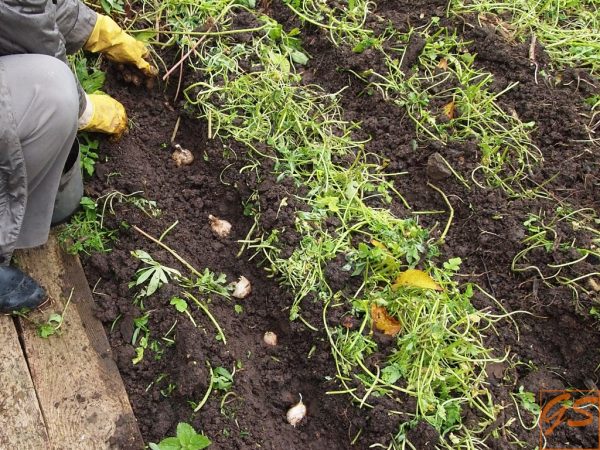
Planting winter garlic between green manure crops.
If you like to experiment, try sowing part of the plot allocated for growing garlic with annual green manure (mustard, phacelia, oats). Sow not the entire area, but in rows, leaving row spacing for garlic. If the green manure plants have gained good vegetative mass by the time the garlic is planted, cut them down, chop them a little with a shovel and leave them to rot in the garden bed.
The bed is dug up using a spade, carefully selecting the rhizomes of field bindweed, wheatgrass and other perennial weeds.If you water the garden bed several times before planting garlic, you can significantly reduce the supply of annual weed seeds. They watered it, waited for the grass to sprout, and raked the garden bed lengthwise and crosswise.
Planting winter garlic
The optimal planting time for garlic is October. Before the onset of winter weather, garlic has time to take root, but its leaves do not grow. Early planting can weaken the plants: the garlic will begin to “grow” leaves, consuming the nutrients of the clove, and the leaves will be killed by frost.
In the spring, the weakened teeth will have to “work” on the leaves again. This is why garlic planted early in the fall produces smaller heads than garlic planted in October.
The rows on a garlic bed are spaced every 20-25 cm. A clove from a clove in a row is planted every 6-12 cm (the larger the cloves, the greater the distance between them).
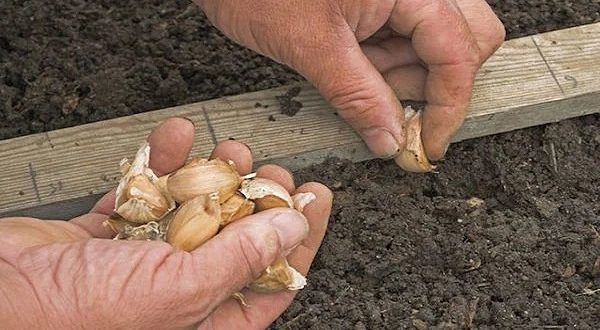
You cannot plant garlic often, otherwise you will end up with small heads.
It is very important to maintain the planting depth. If you plant small, the cloves may freeze in winter and “cook” in overheated soil in summer. If you plant deep, you will get small heads.
In a well-leveled bed that is ready for planting, make furrows 8-10 cm deep, carefully lay the cloves or single-claws bottom down, fill them in, lightly compact the soil and mulch with a two- to three-centimeter layer of compost.
The teeth are not pressed into the soil so as not to damage the root primordia at the bottom.
When planting garlic, the hoe can be replaced with a thick stake with a pointed end. With its help, holes are made in the garden bed to the required depth (on such a primitive “planter” you can make a notch equal to the depth of the cloves) and carefully, bottom down, cloves and single-claws are thrown into them.
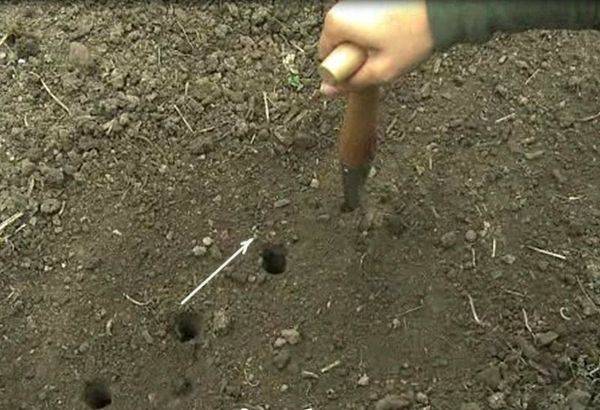
Planting garlic using a pointed stake
Having planted everything, the “holes” in the garden bed are filled with a rake, and the soil surface is mulched. You can throw twigs on the bed that will trap snow in winter. It is necessary not only as additional protection from frost, but also as a source of moisture. In spring, garlic begins to vegetate early, and irrigation water in many summer cottages does not appear until late April-early May.
At the same time as cloves and cloves, but preferably in different beds, bulblets (aerial bulbs) are planted. Furrows are made 15 cm apart from each other and the bulblets are sown - about a centimeter apart from each other. The planting depth is 4-5 cm. Next summer you will receive healthy planting material - single cloves, there will be no bacteriosis on them.
If there is enough land on the site, the bulbs can be planted less frequently - every 3-4 cm. With this planting, the garlic is dug up after a season and large bulbs are obtained.
Garlic bed care
To make the heads grow large, be sure to use fertilizer.
In early spring, garlic that begins to grow is fed with urea - a tablespoon per bucket of water. In April-May can be used for fertilizing organic infusions (mullein 1:10, bird droppings 1:20, consumption - 2 liters per sq. m).
It is important to ensure that the garlic bed is not overgrown with weeds.
Their competition affects the yield and size of the bulbs. The heads also become smaller if the garlic shoots are not trimmed in time (when they are 8-10 cm long). Several arrows are left in order to orientate yourself when to dig garlic for propagation.
Two weeks before the expected harvest date, stop watering the garlic.
They dig for garlic when the covers of the inflorescences crack and the leaves begin to turn yellow.If you delay, the bulbs will begin to disintegrate into cloves and will not be stored.
The dug up garlic, without cutting the tops, is tied into bunches or braided and dried in a ventilated area. The stems of the dried heads are cut off, leaving small stumps, and the roots are trimmed, being careful not to damage the bottom.
You can store garlic in a dry, cold room. Lowering the temperature to zero or even slightly below zero is not dangerous for garlic.
Is there no such place? Garlic keeps quite well at room temperature. But with warm storage, losses are greater. In addition, teeth, if planted in the spring, develop worse. After all, this is a winter crop and requires lower temperatures to thrive in winter.
In early spring, you can plant garlic that has not been used up over the winter. It will no longer be stored, but in the garden it will produce an additional harvest: mainly unusually large one-toothed ones. They can be planted in the fall to produce very large heads of garlic, or used for culinary purposes.
Large-fruited varieties of winter garlic
|
Titanium ripens in 100-115 days from the date of emergence. This is a shooting variety intended for cultivation in open ground. The plant is of average height - 35 cm, width of the tops - 3 cm. The heads are large, weighing up to 150 g. Each has 5-6 cloves, 20-25 g each. The bulb itself is round-flat, the scales are purple-white. The color of peeled garlic is white. The yield per square meter reaches 1.9 kg. The shelf life of the harvested crop is 5-6 months. |
|
Alekseevsky, often called Alekseevsky giant, has large heads up to 180 g with white husk. The bulb contains 4-5 large teeth in one row. This variety is disease resistant. The taste is sharp-sweet, the smell is pronounced. |
|
Lyubasha - a well-known large variety of garlic, the mass of the heads of which is 100-120 grams. With proper care and in good soil, the bulb grows up to 150 g. The husk is white with a pinkish tint. The feathers are tall and wide. The cloves are arranged in one row, there are no more than 9 of them, the scales are white and cream. Productivity is high. |
|
Casablanca - a variety of Dutch selection. Garlic peel is white. The head is up to 200 g, combines approximately 8-12 cloves with beige scales. The variety is advantageous because it can be stored for a long time, has commercial qualities, high yield (55-60 t/ha) and resistance to some diseases. |
|
Moskal – a variety of Ukrainian selection, high-yielding. The heads have a typical shape, weighing 80-100 g, cloves (4-5 per bulb) weigh 15-20 g. The color of the husk is lilac-white, and the scales are brown. The pulp is white, juicy, sharp, universally used. Shelf life – 5-6 months. |

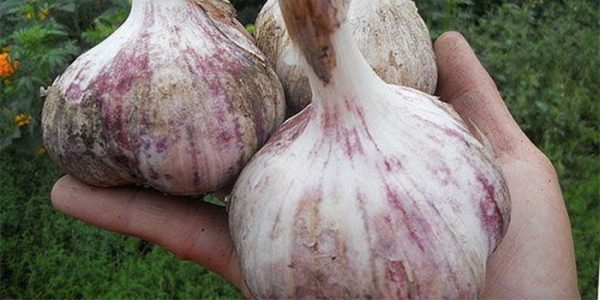
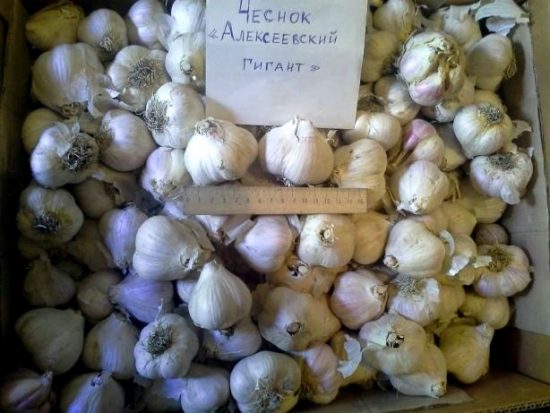
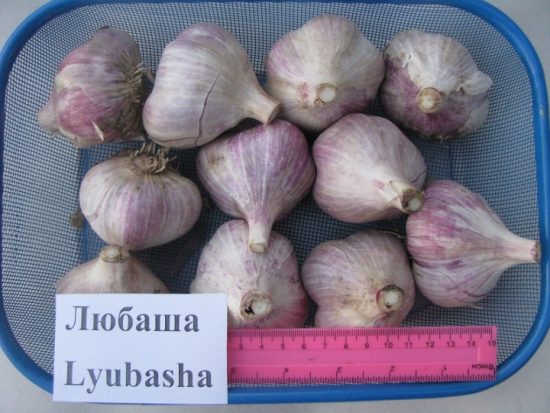
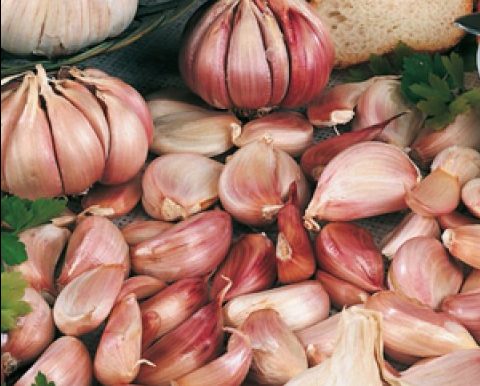
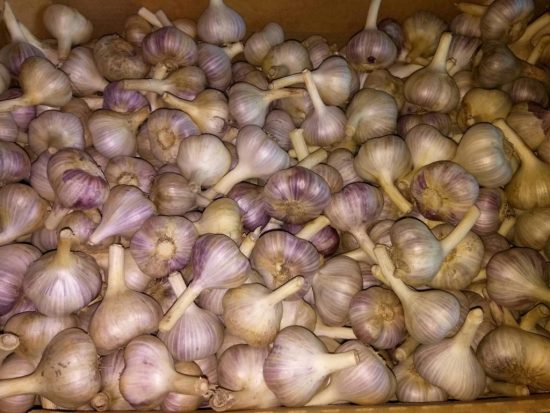

 (9 ratings, average: 4,78 out of 5)
(9 ratings, average: 4,78 out of 5) CUCUMBERS NEVER GET SICK, I'VE BEEN USING ONLY THIS FOR 40 YEARS! I SHARE A SECRET WITH YOU, CUCUMBERS ARE LIKE THE PICTURE!
CUCUMBERS NEVER GET SICK, I'VE BEEN USING ONLY THIS FOR 40 YEARS! I SHARE A SECRET WITH YOU, CUCUMBERS ARE LIKE THE PICTURE! You can dig a bucket of potatoes from each bush. Do you think these are fairy tales? Watch the video
You can dig a bucket of potatoes from each bush. Do you think these are fairy tales? Watch the video
 How our fellow gardeners work in Korea. There is a lot to learn and just fun to watch.
How our fellow gardeners work in Korea. There is a lot to learn and just fun to watch. Eye trainer. The author claims that with daily viewing, vision is restored. They don't charge money for views.
Eye trainer. The author claims that with daily viewing, vision is restored. They don't charge money for views. A 3-ingredient cake recipe in 30 minutes is better than Napoleon. Simple and very tasty.
A 3-ingredient cake recipe in 30 minutes is better than Napoleon. Simple and very tasty. Therapeutic exercises for cervical osteochondrosis. A complete set of exercises.
Therapeutic exercises for cervical osteochondrosis. A complete set of exercises. Which indoor plants match your zodiac sign?
Which indoor plants match your zodiac sign? What about them? Excursion to German dachas.
What about them? Excursion to German dachas.